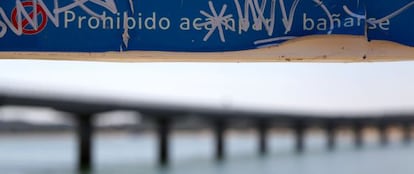Girls’ deaths at Valmayor spark debate over supervision of city’s rivers and lakes
Agencies dispute responsibility for signs and patrols


Following the deaths of two young girls last Sunday afternoon in a Madrid reservoir, questions are being asked about who is responsible for overseeing the region's rivers and lakes.
Diana Elizabeth M. C. (age 13) and Joseline Ander W. C. (14) were paddling in the reservoir at Valmayor when they fell into an underwater crack and were unable to escape. Neither of the two girls knew how to swim, according to family members at the scene.
Swimming is prohibited in all the region's reservoirs and rivers, except for the San Juan reservoir and some points along the River Alberche. Sources from the Madrid regional government claim that responsibility for warning signs and supervision of the waterways belongs to the Civil Guard.
Responsibility for Madrid's waterways is clearly defined. Rivers and subterranean pools come under the Tajo Hydrographic Confederation, while reservoirs (apart from San Juan) fall within the orbit of Madrid's water authority, Canal de Isabel II. The waters in these reservoirs are destined for human consumption, and for that reason the board is tasked with keeping them clean and with putting up signs to warn when, for instance, bathing or camping is forbidden.
There is a prohibition against swimming and people must comply"
"There is a prohibition against swimming and people must comply, even if they are not reminded with a sign every so-many meters. The reservoirs are very big and it would be very difficult to put signs all the way around," said a source from the water authority, adding that the shores of the reservoirs changed each year due to rain. "It would be like having to put up a sign banning fire in all forests. You cannot have a sign every two meters."
In addition to the debate on signs, the tragic accident has also led to a dispute over who is responsible for supervising swimmers in these areas. Sources from the Madrid regional government claim that it is not their job and that it falls to Canal Isabel II.
The public water company has security guards that protect important reservoir installations, such as dams. The guards patrol the exterior perimeters but are not charged with supervising swimmers. "Above all, they protect the operations of the water company," explained a source from Canal de Isabel II.
The duties then fall directly to the Civil Guard's Nature Protection Service (Seprona). Agents attached to Seprona have special vehicles such as motorbikes and all-terrain cars to move around the countryside and could also intervene in incidents at reservoirs.
Civil Guard sources recognize that the duty falls within their remit, although not exclusively. In fact, forest officials, charged with protecting the environment, could also participate in controlling the region's waterways. They also have the power to sanction rule-breakers.
A lot of people live in Madrid and it is impossible to supervise them all"
The local police also have jurisdiction and could and should also be tasked with patrolling potential danger spots. "Just as they issue fines for traffic offenses, they could report people breaking the 'no swimming' rules," the Civil Guard argues.
The main problem that faces the various administrations is the size of the reservoirs. Valmayor, the second biggest in the Madrid region, is 12km long and has a surface area of 755 hectares. This makes it very difficult to police the "no swimming" zones, especially on days like last Sunday when thousands of people flocked to the area.
"Many times we have told people not to swim, but as soon as we are gone they have got in again even though it is very dangerous," says the Civil Guard. "A lot of people live in Madrid and it is impossible to supervise all the recreation areas."
Captain Carlos Martínez, from the Civil Guard Special Subaquatic Activities Group (GEAS), explained that swimming in rivers and reservoirs is more dangerous than in the sea. The reason for this is that currents and swirls may appear unexpectedly. There is also the problem of silt building up on the bottom. This is disturbed by the movement of the water and by footsteps and prevents swimmers from being able to judge depth. The captain's advice is to keep to designated swimming areas.
On Sunday, while Civil Guard divers were recovering the bodies of the two girls, some youths were paddling on the shore, oblivious to what had happened.
So far this year 113 people in Spain have died by drowning.
Tu suscripción se está usando en otro dispositivo
¿Quieres añadir otro usuario a tu suscripción?
Si continúas leyendo en este dispositivo, no se podrá leer en el otro.
FlechaTu suscripción se está usando en otro dispositivo y solo puedes acceder a EL PAÍS desde un dispositivo a la vez.
Si quieres compartir tu cuenta, cambia tu suscripción a la modalidad Premium, así podrás añadir otro usuario. Cada uno accederá con su propia cuenta de email, lo que os permitirá personalizar vuestra experiencia en EL PAÍS.
¿Tienes una suscripción de empresa? Accede aquí para contratar más cuentas.
En el caso de no saber quién está usando tu cuenta, te recomendamos cambiar tu contraseña aquí.
Si decides continuar compartiendo tu cuenta, este mensaje se mostrará en tu dispositivo y en el de la otra persona que está usando tu cuenta de forma indefinida, afectando a tu experiencia de lectura. Puedes consultar aquí los términos y condiciones de la suscripción digital.








































